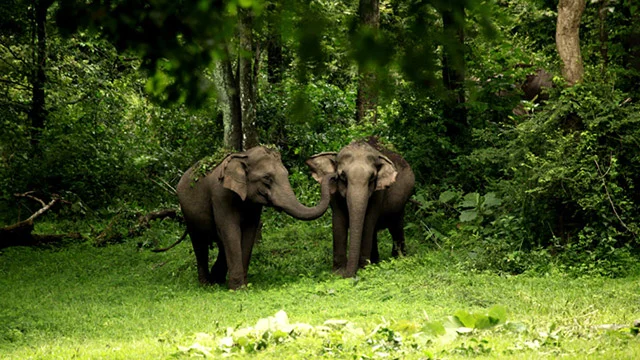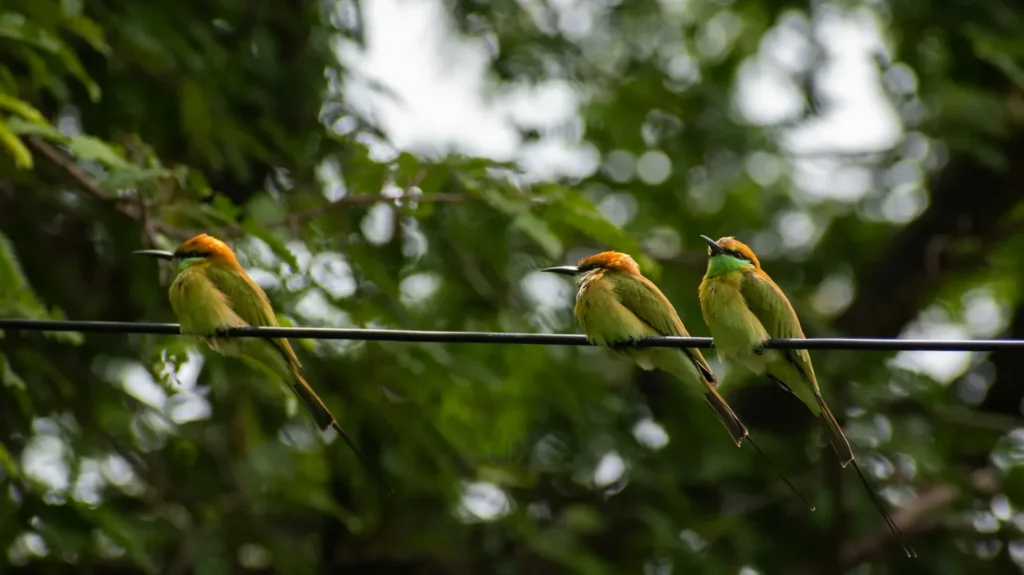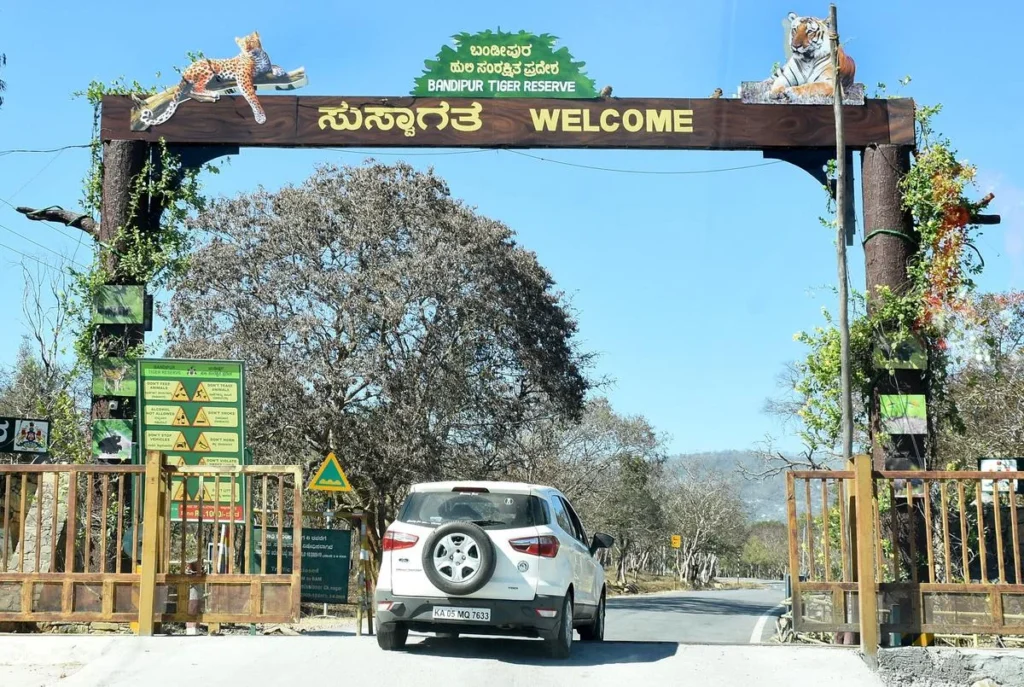
Bandipur National Park and Forest is a prominent and beautiful wilderness haven known for having a good population of tigers. It is nestled amidst the picturesque surroundings of the beautiful Western Ghats mountains on the Mysore-Ooty highway in Karnataka. Bandipur spans over an area of 874.2 sq km and has over 173 Royal Bengal Tigers. In 1973, it was given the title of Project Tiger.
Combined with Mudumalai Wildlife Sanctuary, Nagarhole National Park, and Wayanad Wildlife Sanctuary, it makes the biggest biosphere reserve in India. It is collectively known as the ‘Nilgiri Biosphere Reserve.’
The reason Bandipur is so famous is because it is part of the Tiger Reserve project, and with the efforts, the number of tigers has increased from 12 to 173 as per an estimate in 2023. The other inhabitants found in the Bandipur reserve forest include gaur, sambar, and chital deer, four-horned antelope, sloth bear, panther, porcupines, and more. It is also home to the elusive black panther, another fab favorite here. Moreover, Bandipur National Forest is also home to many species of migrated and local birds. These include birds like green pigeons, jungle fowl, and more.
Geography

Location
Bandipur Tiger Reserve officially came into existence in 2007. This section talks about Bandipur National Park’s location and more. The tiger reserve is nestled in two continuous landscapes spanning over two revenue districts of Karnataka. One is Mysore and Chamarajanagar. These are unique landmasses nestled at the tri-junction areas of Karnataka, Kerala, and Tamil Nadu.
The latitudes of Bandipur Forest are these. They lie between the east longitudes of 760 12’ 17” and 760 51’ 32” and the north latitudes of 110 35’ 34” and 110 55’ 02”. It is also part of the Western Ghats tiger landscape and consists of the Mudumalai Nagarhole Tiger Reserves & Wayanad Wildlife Sanctuary.
Moreover, the southeastern portion of the reserve gets connected to the nearby landscape of the BRT Tiger Reserve, Cauvery Wildlife Sanctuary, and M.M. Hills via the Sathyamangalam Tiger Reserve.
How to reach Bandipur Forest Reserve?
One of the best ways to reach the Tiger Reserve in Bandipur is via NH 67. The park is located midway on NH 67 and is almost 80 km away from Mysore and Ooty.
With taxis, state buses, and other transportation modes, getting here is easy.
By Air: If you want to fly to Bandipur National Park, you can fly to the nearest airports: Mysore (80 km), Coimbatore (200 km), and Bangalore (230 km). From these airports, cabs via NH67 are ideal to reach the park.
Note: If talking about access, the internet facilities here are good along with other civic amenities.
Terrain
Bandipur National Park, Karnataka, India, is known for its diverse terrain, including valleys, forests, grasslands, hills, and rugged slopes. Bandipur forest is nestled at an elevation of 680-1,454 meters above sea level. The park’s distinctive elevation is the reason there is a variety of biomes in Bandipur National Park, including deciduous and dry forest, grasslands, and shrublands. Also, a few streams, rivers, and waterholes, like the Nugu and Moyar Rivers, do pass through the park. Moreover, the park’s soil is shallow, especially on the hilltops, while it is deep in the valleys. Also, the terrain has a few rocks, including gneiss, mica, hornblende, schists, and metamorphic.
Due to the variety of terrain and a supportive climate, Bandipur is home to a variety of animals and plants. The seasonal changes also bring splashes of color to the landscape of the park with many herbs and wildflowers. The common wildflowers and herbs here include the Indian borage, Himalayan cobra lily, and flame lily.
Ecosystem

Flora
Bandipur Forest is home to various species of timber, flowering trees, and shrubs. Yes, the park is known for its wildlife, but the flora here makes it a haven for nature lovers. The Indian subcontinent has a vast variety of flora, and Bandipur’s flora will mesmerize you. Here is a brief about the flora here.
Importance of the Flora
Bandipur flora has an aesthetic value, for sure, but it is important in maintaining the ecological balance of the park. The plants here are necessary for providing food and shelter to the various animals you will find here. These include animals, insects, and birds. This makes up the diverse ecosystem of the park. From preventing the water flow to controlling soil erosion, Bandipur flora is imperative to the existence of the park.
Trees
Bandipur is known to have many species of trees, including teak, rosewood, sandalwood, and bamboo. The trees are important for the survival of both animals and humans. The locals here use the sandalwood to produce perfumes and many other cosmetic products. On the other hand, rosewood and teak are valued highly for their durability and strength; this makes them a perfect choice.
Bushes and Shrubs
Bandipur has many shrub species and bushes important for the ecosystem of the park. These plants are known for providing shelter and food to many animals and birds, including elephants, monkeys, and deer. The most known bushes and shrubs found here include black pepper, Indian coral tree, and Indian gooseberry.
Herbs and wildflowers
The park’s herbs and wildflowers make the environment colorful here while making the landscape beautiful. These herbs and wildflowers are the food source of birds and insects. Moreover, they also have medicinal properties. The most common herbs and wildflowers you will find here include flame lily, Himalayan cobra lily, and Indian barrage.
Medicinal Plants in Bandipur
It is home to many species of medicinal plants used by locals for eons to treat many ailments. The best medicinal plants here include Indian barberry, Indian sarsaparilla, and Indian gooseberry.
Rare flora in Bandipur
You will find several species of endangered and rare flora here which are under threat due to human activities and habitat loss. The rare and endangered species of flora you
Conservation Efforts for Flora in Bandipur
To protect the flora of Bandipur, the park’s authorities have implemented several conservation measures. These measures include the establishment of a seed bank, the creation of wildlife corridors, and the implementation of strict anti-poaching laws. The park’s authorities also work closely with local communities to raise awareness about the importance of conservation.
P.S. The best time to visit flora in Bandipur forest is during the monsoon season. From June to September, the rain showers also nourish the soil, and the plant flourishes; this makes the park a green paradise. The entire forest is covered with new and fresh growth. If you want to watch a few rare plants like Rhododendron bloom, then you can head here between February and March. These bright and beautiful flowers are usually found in higher-altitude park areas, offering a breathtaking sight. Even in the months from October to December, the park has a variety of flowering plants like Indian laburnum, Indian coral tree, and flame of the forest.
Fauna
Bandipur is known for its wide variety of fauna especially the majestic Bengal Tiger. The park is also home to approximately 173 tigers, a huge number. These elusive cats are the animals tourists come here from around the globe. You will find them in shade or searching for prey. But the Royal Bengal Tigers are not the only cat species you will find here. You can get to see Indian lions and Leopards. The herbivore species you will find here include Asian elephants, spotted deer, sambar deer, wild boars and chital. You can also spot these animals foraging in the meadows and forests of the park. For bird lovers, Bandipur is a paradise as there are over 200 bird species including the colorful peafowl, rare Malabar pied hornbill or the majestic Indian eagle-owl.
Endangered species in Bandipur National Park
Bandipur is home to many endangered species like the Indian elephant, gaur, leopard and tigers. These animals are here under the wildlife protection act of India, this means, they get special attention by the forest authorities. Other endangered animals here include Indian wild dog or dhole, the rarest canids in the world.
Mammals of Bandipur Forest Reserve
The rich mammalian diversity here attracts wildlife lovers all over the globe. There are over 80-species of mammals here including the iconic Indian elephant, Bengal tiger, gaur, sambar, chital, wild boar, leopard and more. These are the popular mammals here but other species you will see here include Indian pangolin, dhole, hyena, mouse deer and barking deer.
Bandipur is known for its rich mammalian diversity, with over 80 species recorded within
Reptiles and Amphibians in Bandipur
Bandipur is also home to many amphibians and reptiles with over 50-species of snakes like King Cobra or Indian rock python or even the common krait. The variety of lizards here also include chameleons and monitor lizards. The species of amphibians here include toads, salamanders and frogs.
Avifauna of Bandipur
Bandipur Forest is an ideal place to head to if you love watching birds. There are over 200-species of birds recorded within the boundaries. The park is also home to many raptors like the crested serpent eagle, osprey and black eagle. The other animals you will spot here are the rare grey-headed fish eagle, painted stork and Indian roller.
Insects and invertebrates in Bandipur
The park is known for its rich diversity of invertebrates and insects. Butterflies are found here in abundance and there are over 100-species recorded within the park. The other notable insects here include stick insects, cicadas and giant atlas moths.
Conservation efforts for fauna in Bandipur
The forest authorities of Bandipur take serious steps for conserving the park’s rich biodiversity. For instance, there are strict anti-poaching measures ensuring safety of animals especially the tigers and elephants, who are poached for their fur and teeth respectively.
Other conservation efforts here include habitat management and scientific research. Apart from that, community-based conservation initiatives are also initiated by the forest department promoting sustainable tourism while reducing human-wildlife conflict.
Best time for spotting the most fauna
If you are heading to Bandipur forest for spotting wildlife, the best time is between October to May. During this time, the sightings are higher and also you can head here between the months of November to February, ideal for spotting the ‘Royal Bengal Tigers’ and other mammals like elephants or Indian gaur. If you are into birdwatching or butterfly spotting, head here between March to May and you will find the park being home to colorful birds.
Conservation Efforts

Protected Area Status: Bandipur National Park
Bandipur National Park, located in Karnataka, India, is designated as a protected area under the Wildlife Protection Act of 1972. It covers approximately 872 square kilometers and is a vital ecological corridor connecting the Western Ghats and the Nilgiri Biosphere Reserve. The park’s protected status is vital for conserving its diverse biodiversity, including populations of tigers, elephants, and various other endangered species. Protected areas like Bandipur provide essential habitats, support ecological balance, and prevent human encroachment and poaching. This status allows for scientific research, conservation programs, and eco-tourism to coexist, ensuring that the park’s unique ecosystems are preserved for future generations.
National Park Designation: Bandipur National Park
Bandipur National Park, established in 1974, is one of India’s most prominent national parks. Located in the Chamarajanagar district, it spans 872 square kilometers and is home to diverse flora and fauna. It is part of the Nilgiri Biosphere Reserve and is known for its significant population of tigers and elephants. As a national park, Bandipur is managed to conserve biodiversity and maintain ecological processes by restricting hunting, mining, and agricultural activities. Visitors and conservationists value it for its role in wildlife protection, tourism, and education. The park also serves as a strong example of effective conservation strategies, thanks to stringent wildlife monitoring and research programs.
Wildlife Sanctuaries: Bandipur National Park
While Bandipur National Park itself is a national park, it is also often referred to as a wildlife sanctuary due to its role in wildlife protection. It provides safe habitat for over 70 species of mammals and over 250 species of birds. Among its most notable residents are tigers, elephants, leopards, and sloth bears. The park acts as a refuge for endangered species by offering undisturbed habitats and a breeding ground. The management of Bandipur focuses on maintaining its wildlife sanctuaries’ ecological balance through anti-poaching patrols, habitat restoration, and community engagement. These efforts help protect its vast biodiversity and the surrounding buffer zones.
Ranger Patrol Routes: Bandipur National Park
Ranger patrol routes in Bandipur National Park are strategically designed to monitor and protect wildlife and ensure the park’s security. These patrols are vital in preventing poaching and human-wildlife conflicts while helping monitor the park’s ecological health. Regular ranger routes allow teams to track wildlife movements, inspect for signs of habitat degradation, and enforce conservation laws. With its expansive terrain, effective route management ensures comprehensive surveillance and timely intervention against threats like poaching and encroachment. Patrols use a combination of foot routes and motorized vehicles to maintain constant vigilance over key wildlife corridors within the park.
Cultural Significance

Historical Relevance: Ancient Temples & Tribal Settlements
Bandipur National Park holds significant historical and cultural importance, with evidence of ancient temples and tribal settlements adding to its allure. The park is surrounded by regions with ancient archaeological sites, such as Hindu temples that date back centuries, reflecting the area’s rich cultural heritage. These temples are important markers of the region’s spiritual history, showing the integration of religion and nature in the lives of the local populations.
Additionally, the region around Bandipur has historically been inhabited by various tribal communities who lived in harmony with the environment. Tribes such as the Soligas have traditional knowledge of local flora, fauna, and ecological systems. Their ancient practices of forest conservation, sustainable hunting, and agriculture have influenced the preservation of the region’s natural balance.
The coexistence of cultural heritage and biodiversity within Bandipur adds depth to its ecological role, highlighting the intersection of conservation and history. These elements offer valuable insights into the relationship between human societies and natural landscapes over centuries.
Ecotourism
Bandipur National Park is known for its efforts in ecotourism opportunities. It blends exploring the wildlife with sustainable travel. The jungle safari lets the visitors observe iconic species like elephants, leopards, sloth bears, and tigers in their natural habitats. The safaris here include:
- Bus safari is ideal for large families and runs for almost 2 hours.
- Gypsy or jeep safari is ideal for individuals or smaller groups and is an adventurous way to explore the biodiversity here.
- Canter safaris are also ideal for big groups, but they are run for a limited time.
All the safaris are guided by experts, ensuring you learn about the wilderness here in the best manner. Moreover, they are sustainable, and the guides take you to the best spot where chances of spotting the wildlife are higher.
Additionally, the park also has well-maintained trekking trails ideal for nature walks. This allows visitors to explore the diverse landscape, including the riverine ecosystems and deciduous forests. The trails offer a chance for observing the bird species and other wildlife, perfect for eco-conscious adventurers. The trekking is usually conducted by the government or lodges/resorts nearby. This is best for not just trekkers but also for being environmentally sustainable.
Research & Monitoring

Biodiversity Studies: Species Inventory & Habitat Mapping
Biodiversity studies in Bandipur National Park will focus on species inventory and habitat mapping, monitoring, and conserving the ecological richness of the park. A species inventory catalogs all flora & fauna. Till now, the species inventory has documented around 70 mammal species, many reptiles and amphibian species, and 250 bird species. The inventor is necessary for identifying vulnerable and endangered species like Indian elephants and tigers. It helps them assess the health of the population and keep their number high.
Habitat mapping means analyzing various ecosystems in Bandipur, like the deciduous forests, riverine areas, and grasslands. The study also identifies threats to these habitats from climate change, natural processes, and human activity.
Together with habitat mapping and species inventory, it provides valuable insights for conservation strategies, which ensure wildlife protection and ecological stability in Bandipur Forest, a biodiversity hotspot.
Environmental Monitoring: Water Quality Testing & Soil Analysis
Bandipur forest reserve also goes for environmental monitoring. It is necessary for assessing ecological health. Water quality testing evaluates river systems and seasonal waterholes for sedimentation, pollution, and contaminants. This ensures wildlife access to clean water. Moreover, soil analysis measures nutrient levels, soil quality, and erosion patterns, determining the park’s ability to sustain wildlife habitats and vegetation.
The monitoring efforts are necessary as they help you identify environmental stressors like deforestation, climate change, and agricultural runoff. This threatens the ecosystem of the park. With consistent testing, researchers will be able to implement conservation to reduce degradation while maintaining the ecosystem balance. Environmental monitoring is also necessary for adaptive management, ensuring long-term ecological stability.
Challenges

Deforestation Threats
Deforestation is one of the most significant threats to Bandipur National Park. It impacts the ecological balance and biodiversity issues here. A driving factor is illegal logging depleting the rich resources of the park, which threatens the wildlife. Agricultural expansion and enrichment by the local communities into forested areas do lead to habitat fragmentation, reducing connectivity for species dispersal and migration.
Other major threats to deforestation are fire incidents, both human-induced and natural. It further increases deforestation as it destroys vast stretches of forests, which impacts both the fauna and flora alike. Moreover, infrastructure development like road construction can lead to habitat degradation as it fragments the wildlife corridors and creates chances for poachers to reach the park. These threats reduce the ability of the park to support the rich biodiversity, including iconic species like elephants and tigers. The conservation initiatives focus on community engagement, habitat restoration, strict anti-logging enforcement, and more.
Wildlife Poaching
Bandipur Forest is a tiger conservation reserve set up by the government for protecting tigers and other major endangered species. This means taking strict anti-poaching measures. Unfortunately, wildlife poaching is still a major threat to the biodiversity of Bandipur National Park. It endangers species like leopards, elephants, tigers, and more. Poachers target animals for their body parts, like bones, skins, and tusks, due to their high demand in illegal wildlife trade markets. To combat this, anti-poaching initiatives are implemented, like increasing patrolling, strict enforcement of wildlife protection laws, and community education.
The surveillance system also plays a major role in detecting poaching activities and preventing them. These include the use of drones, camera traps, satellite imaging, ranger patrols, and more. All these monitor key wildlife corridors, tracking illegal activity. Technology enhances the ability to respond to threats quickly while ensuring timely intervention. Moreover, collaborating with local communities, conservation organizations, and law enforcement fosters shared responsibility for protecting the wildlife.
Frequently Asked Questions About Bandipur Forest
What is Bandipur forest famous for?
Bandipur National Park, the second highest tiger population in India, is famous for being a tiger reserve and is located in Gundlupet Taluk. It is also known for being the largest protected area in Southern India and being the largest habitat of wild elephants in South Asia. It is also known for being home to many species of mouse deer, shelter sambar, sloth bear, and the rare flying lizard. Also, there are over 200 species of birds and diverse flora like rosewood, sandalwood, Indian Kino tree, giant clumping bamboo, and more.
Which district is Bandipur Forest in?
Bandipur National Park is situated in Gundlupet Taluk of Chamarajanagar district and partly in H.D. Kote and Nanjangud taluk, Mysore district. It spans 872.24 square kilometers and is a haven for animal lovers and wilderness.

